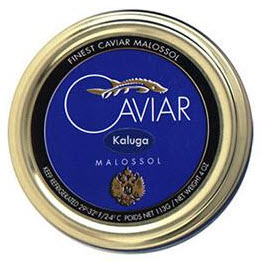Kaluga hybrid caviar comes from a hybrid created from the sturgeon species Huso dauricus and Acipenser schrenckii. This caviar is chiefly produced in China.
The caviar is sometimes marketed as River Beluga. Both H. dauricus and A. schrenckii are native to the Amur river and is found in the border region between China and Russia.
Since H. dauricus and A. schrenckii are both critically endangered in the wild, caviar from Kaluga hybrids raised in captivity has become a popular alternative for those looking for legal and sustainable caviar, especially as an alternative to beluga caviar.

Eating Kaluga hybrid caviar
Kaluga hybrid caviar is praised for its rich, creamy and buttery taste, which is perfectly balanced with the saltiness. The pearlescent eggs varies in color from dark gray (almost black) to light golden green. They are firm and fairly big, but not as big as belugas.
Kaluga hybrid sturgeon
Below, you will find information about the two species used to create the hybrid Huso dauricus x Acipenser schrenckii.
Kaluga sturgeon (Huso dauricus)
- Kingdom: Animalia
- Phylum: Chordata
- Class: Actinopterygii
- Order: Acipenseriformes
- Family: Acipenseridae
- Genus: Huso
- Species: H. dauricus
Conservation
The Kaluga sturgeon is listed as Critically Endangered on the IUCN Red List 3.1. This is the most severe category for endangered species; the next step would be Extinct in the Wild.
Geographical range
The Amur sturgeon live in the Amur River basin in China and Russia.
Description
The largest known specimens were 5.6 meters in length and weighed around 1,000 kg. This makes the Amur sturgeon one of the larger species of sturgeon, but not as big as the Beluga sturgeon.
The Amur sturgeons have gray-green to black backs, while the ventral areas are of a yellowish green-white color.
Reproduction
 Kaluga sturgeons migrate from saltwater to freshwater to breed. Spawning peaks from the end of May to July. There are two distinct populations of Kaluga sturgeon in the Amur river; one that spawns in the main stem of the river and another one that spawns downstream and work their way to the middle of the river.
Kaluga sturgeons migrate from saltwater to freshwater to breed. Spawning peaks from the end of May to July. There are two distinct populations of Kaluga sturgeon in the Amur river; one that spawns in the main stem of the river and another one that spawns downstream and work their way to the middle of the river.
Spawning periodicity is 4-5 years in females and 3-4 years in males.
The onset of sexual maturity in females is impacted by water temperature. During warm years, females tend to spawn a year earlier.
Amur sturgeon (Acipenser schrenckii)
- Kingdom: Animalia
- Phylum: Chordata
- Class: Actinopterygii
- Order: Acipenseriformes
- Family: Acipenseridae
- Genus: Acipenser
- Species: A. schrenckii
Conservation
The Amur sturgeon is listed as Critically Endangered on the IUCN Red List 3.1. This is the most severe category for endangered species; the next step would be Extinct in the Wild.
Geographical range
The Amur sturgeon live in the Amur River basin in China and Russia. Claims of its presence in the Sea of Japan remains unconfirmed.
Description
This sturgeon can reach up to 3 meters in length and weigh nearly 200 kg. It is grayish-brown on its back, with pale ventral areas.
Reproduction
Males mature sexually when they are 7-8 years old; females a little later, usually around 9-10 years of age.
Migration starts in autumn.
